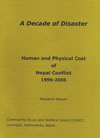|
|
War is dirty business. Unconventional wars are even more so-they devastate the landscape unrecognisably. People die in ways normally unimaginable. Fathers cremate their sons.
In internal armed conflicts, friendly forces and enemies are identical in appearance. Every tool has the potential of being used as a weapon. The harder a state tries to win, the deeper it sinks in the quagmire of retribution and reprisal.
'Collateral damage' is higher in internal armed conflicts, since the line between the militant and the militia is so thin. The farmer in the paddy field may be a militia in mufti. The youngster in telltale boots in the bus may be a real soldier. Or not.
There is no proven way to calculate the impact of a war. The consequences of the Doramba killings or the Madi massacre are impossible to calculate. You can't put a price on the grief of a widow, an orphan or aged parents.
The cost of war is a rough estimate of identifiable losses and opportunities. It's basically a guesstimate. As the peace process moves along, it can be instructive to look back and see what we have collectively lost in the last decade of conflict. That, say the researchers of the report A Decade of Disaster, is their main objective.
The subtitle of the report is more appropriate: Human and Physical Cost of the Nepali Conflict, 1996-2005. The term 'disaster' sounds rather too banal to describe a conflict that tore our social fabric apart. That's another problem with this publication: the choice of words, sentence structures, and the writing style makes a reader wish the report were in Nepali. Come to think of it, why is it published in English anyway?
Among other tallies of death and destruction, the report lists number of children killed in the conflict by gender, district and region in detail that can be shocking if we pause to think that every child had a story, a future and two grieving parents. Other than shock value, however, it's difficult to see how such numbers will be of any use in designing post-conflict rehabilitation and reconstruction measures.
Despite the desolation it brings, war is a lucrative business for some. Merchants of death benefit most from shady weapon deals done in the heat of war. War means bigger budgets, faster promotions, less transparency, bigger contracts and bigger kickbacks.
Though the book is a rehash of published statistics and contains very little original data or information, it can be a handy reference for consultants to prepare powerpoint presentations and for donors interested in rehab and recon. To the rest of us, it's a timely reminder that war is too important a matter to be left to commissars in grey shirts and generals in olive green. After the April Uprising, it's incumbent upon us to give peace a chance. Real freedom, as Jean-Paul Sartre observed, is what we do with what has been done to us.
CK Lal

A Decade of Disaster: Human and Physical Cost of Nepal Conflict,
1996-2005
A Research Report, May 2006
Page: vi+134, Price: Rs 500
Community Study and Welfare Centre (CSWC)
COUNTING OUR LOSSES 1996-2006
| Total number of people killed | 13,190 |
| Teachers Killed | 173 |
| Childrens Killed | 446 |
| Municipal property destroyed | Rs 41.58 million |
| DDC property destroyed | Rs 33.06 million |
| Telecommunication facilities destroyed | Rs 358 million |



